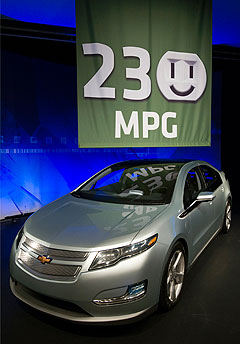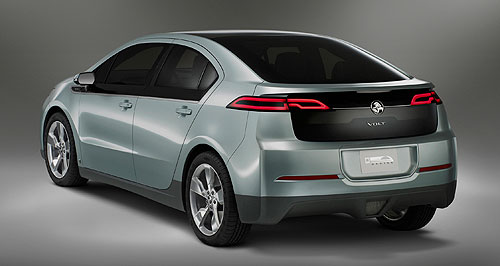Future models - Holden - VoltHolden expects 1.2L/100km city economy for VoltCity slicker: Holden's Volt plug-in hybrid is set to arrive in 2011. Holden’s plug-in hybrid to offer ultra-low city economy as GM proclaims 230mpg Volt14 Aug 2009 By TERRY MARTIN HOLDEN has wasted no time following parent General Motors’ lead in touting the extraordinary fuel economy of the forthcoming Chevrolet Volt – claimed to be 230mpg on the city cycle – and provided a clue this week as to how the plug-in hybrid will be marketed in Australia when it arrives here with a Holden badge early next decade. As the federal government considers how to treat plug-in hybrids and electric vehicles (EVs) under the current ADR 81/02 fuel consumption standard, Holden has reaffirmed its plan to introduce the Volt in Australia by 2012 and calculated that, based on GM’s 230mpg claim, the car should achieve 1.2L/100km. This figure is based on a draft rating methodology for EVs and plug-in hybrids under development by the US Environmental Protection Agency (EPA), which makes it impossible to compare directly with the most fuel-efficient cars currently available. In Australia, the benchmark is the Toyota Prius hybrid, which consumes 3.9L/100km on the city cycle – the same as its combined figure, which not even the Mini Cooper D diesel (also with 3.9L/100km combined) can match, with 4.7L on the urban test. Soon after GM chief executive Fritz Henderson revealed the Volt’s startling fuel economy figure, the US EPA said in a statement that it had not tested the vehicle and could therefore not confirm GM’s claim, but it applauded the US car-maker’s “commitment to designing and building the car of the future”.  Left: The Chevrolet Volt and GM's "230mpg" banner in Detroit. Left: The Chevrolet Volt and GM's "230mpg" banner in Detroit.In making the announcement, Mr Henderson said the Volt was now expected to be the first mass-produced vehicle to claim triple-digit combined and city cycle mileage of “at least” 230mpg. He said it was also projected to achieve electrical efficiency of 25 kilowatt hours per 100 miles, using the same draft EPA calculations. “How is this kind of fuel economy possible? It’s very simple. The Volt can travel up to 40 miles (64km) on a single battery charge before its flex-fuel-powered engine generator kicks in to extend its overall range to more than 300 miles (483km),” Mr Henderson said. “Since three-quarters of Americans commute fewer than 40 miles a day, most Volt drivers will operate on a daily basis without having to use a single drop of gas.” Mr Henderson also claimed that it was much less expensive to drive a car with electricity than petrol. “In Detroit, for example, you can charge the Volt at night, off-peak, for about five cents per kilowatt hour, which means a full 40-mile charge of the Volt will cost about 40 cents,” he said. The GM chief described the triple-digit fuel economy figure as a “game changer” for GM in terms of the impression it will make on prospective customers. He also said that while a combined figure had not been finalised, he was “fully confident” it would also be a triple-digit result. “Are we over-promising? No. We don’t believe we are,” he said. “We’re quite confident under the EPA’s testing methodology that that’s what the customer will see in the city, so I think we’re quite confident in both that as well as having a triple-digit composite number.” The EPA’s draft standard for calculating mileage for plug-in hybrids such as the Volt, which rely on a conventional internal-combustion engine to extend their range, is based on assumptions about the portion of a typical drive (be it city or highway) done in full-electric mode and the amount with the engine running. The test procedure also assumes a single charge each day. GM commenced pilot production for the Volt in June and, according to Mr Henderson, is currently building about 10 vehicles a week. He said more than 30 pre-production Volts were being tested at its proving grounds in Yuma, Arizona, and Milford, Michigan – “so Volt is becoming very real, very fast”. Full-scale production is scheduled for late next year as a 2011 model. Mr Henderson confirmed that GM was testing in both hot and cold climates to validate the performance of the Volt’s lithium-ion batteries, which will be produced at a new $US43 million ($A51 million) plant in Michigan announced this week. He also said that the batteries, together with most of the technology in the vehicle, meant that the first-generation model would be priced well above equivalent-sized conventional-engine vehicles. GM is still to announce a price, but observers expect the Volt to cost more than $US40,000 ($A47,500). “Like all gen-one vehicles, the objective is to get to gen two – but you do need to go through gen one,” Mr Henderson said. “We have different teams actually working on gen two, and even a little bit of work being done on gen three, whose intent is, while we’re launching this Volt, to basically take those learnings and build them into the second and the third generation of the vehicle, so we’re excited about the potential there. But the cost is high.” Mr Henderson would not be drawn on how much of the cost GM would absorb rather than pass on to the consumer in order to its sales targets, although he did acknowledge the Volt would qualify for a $US7500 ($A8900) government tax credit. “In order for us to be successful with the Volt, we need to do a reasonable amount of volume, so we’re going to adopt a marketing strategy that allows us to do that,” he said. “I generally don’t try to go in and say we’re going to subsidise things, because we already have a challenge in terms of getting a recovery from the technology, but that said, we also need the volume.” Asked how Volt owners without a garage were expected to recharge their vehicles, Mr Henderson said there was no simple answer other than the need for a suitable charging station infrastructure. “I’ve thought a lot about that question,” he said. “First of all, I think that over time we see some potential for charging stations to get a broader application. Second, I think if you’re going to park it on the street, I don’t know what to do, actually, because there’s no easy way to do it if you’re going to park it on the street in the suburbs of Back Bay in Boston or something like that. I don’t know how to address that situation. “But I do know that there will be charging stations, there will be rapid-charging stations, and I think we’ll see innovation in this area which will help customers who don’t necessarily have a garage, provide a charge for their vehicles over time. But sitting here today if you park your car on the street or in a parking lot that doesn’t have access to electricity, it’s a problem, and it’s a problem that we and others actually have to go fix.” Holden is understood to be the running to build a hybrid version of its new local small car after the introduction of the conventional-engine version next year. The small car will be built on GM’s Delta II platform – as is the Volt, Astra and Cruze. As GoAuto reported earlier this week, the prospect of Holden introducing a hybrid version of its Commodore early next decade have also been bolstered after GM announced it was preparing to launch an all-new Buick SUV with two hi-tech V6 powertrains – one of which is an upgraded version of the dual-mode hybrid system (using Volt battery technology) combined with a 3.6-litre SIDI V6 engine.  Read more11th of August 2009  Commodore hybrid out of the VoltHolden VE hybrid hopes alive after GM announces plug-in V6 for new Buick SUV15th of June 2009  Electric Cruze a Volt out of the blueGM boss rolls out plug-in Cruze at new US battery lab opening |
Click to shareHolden modelsResearch Holden Motor industry news |















Facebook Twitter Instagram